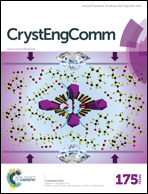Roles of temperature, solvent, M/L ratios and anion in preparing complexes containing a Himta ligand†
Abstract
In order to systematically investigate the influence of factors on the structures of coordination complexes, {[Cu(imta)2]·2.5H2O}n (1), [M(imta)2]n [M = Co (2), Mn (3), Cd (4)], [Pb(imta)2]n (5), and [M(imta)2(H2O)4]·2H2O] [M = Co (6), Mn (7), Ni (8), Zn (9)] {H-imta = 2-[4-(1H-imidazole-1-ylmethyl)-1H-1,2,3-triazol-1-yl] acetic acid} have been prepared and characterized by single-crystal X-ray diffraction analyses. 1 is a 2-D MOF with one-dimensional open channels, and 2, 3 and 4 are isostructural and display (3,6)-connected 3D frameworks which can be simplified into the novel Schläfli symbol of (4·62)2(42·610·83). 5 features a (3,6)-connected topology with the Schläfli symbol of (42·6)2(44·62·89). 6–9 are isostructural and mononuclear, which are further stretched to a 3D supramolecular structure through hydrogen bonding. Based on complexes 2 (or 3) and 6 (or 7), a systematic and comprehensive investigation of temperature, solvent, M/L ratios and anion on complex architectures was carried out. The present results may help unravel the mechanism for the roles that synthesis parameters play in the formation of complex structures and provide insight into the discovery of new interesting compounds. In addition, the photoluminescence properties of 2–9 were also studied.


 Please wait while we load your content...
Please wait while we load your content...